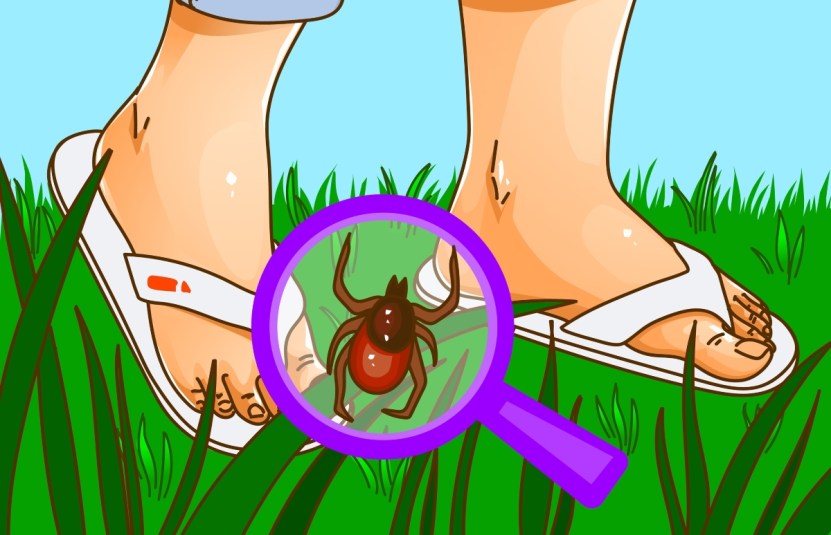Tick on Your Skin? Don’t Throw It Away (Plus Other Tick Mistakes to Avoid)
You don't want to be this kind of host.

You spent the afternoon outside, happily weeding in your garden, watering the plants, trimming the hedges. But as soon as you head back indoors and peel off your muddy shoes and socks, you see it: An oval-shaped, seed-sized bug stuck to your skin. You know what that means… a tick has attached itself to you. This unwelcome gardening buddy is now slowly (but surely) sucking your blood.
Perhaps you don’t even glimpse the tick itself. You might merely notice a red area of skin on your body after a picnic or a walk through the woods — but (wisely) suspect a tick might’ve been there. These “rashes” usually occur in the shape of a circle and spread slowly from the site of a tick bite; sometimes it’ll resemble a target or bull’s eye. Even if you don’t see a tick directly, that doesn’t mean one hasn’t slyly bitten you and then fallen off.
To help you stay safe, we gathered some tips from tick expert Dr. Thomas Mather, PhD, who serves as director of URI’s Center for Vector-Borne Disease and its TickEncounter Resource Center. Dr. Mather’s research focus is on tick ecology, area-wide tick control strategies, and tickborne disease prevention; he also collaborated on the Equip-4-Ticks Resource Center with Insect Shield Repellent Technology, with intent to provide informational content to the public about tick protection. Below, Dr. Mather debunks some common tick myths, plus shares how you can stay vigilant this spring and summer by avoiding certain tick mistakes.
When and where is tick season?
It’s officially tick season. You can encounter these pesky little buggers year-round, but ticks are most active during warmer months, from roughly April to September, according to the CDC. The most common North American tick — and one that carries Lyme disease — is called the Blacklegged (Deer) Tick, and is most commonly found in the US on the east coast. Young deer ticks, or nymphs, are about the size of poppy seeds; adult ticks are the size of sesame seeds. Both nymphs and adults can transmit Lyme disease, and Lyme is most common in the upper Midwest and the northeastern and mid-Atlantic states.
Why do I want to avoid Lyme disease?
Up to 20 percent of Lyme disease diagnoses cause lasting symptoms, including arthritis in the joints, cognitive difficulties, chronic fatigue, and sleep disturbances, again according to the CDC. These symptoms can even persist after an antibiotic treatment, which you need to get very quickly for it to help. Generally, you have about 48 hours to avoid Lyme after a tick bites you. This small window of time is unfortunate, because many people don’t even realize they’ve been bitten until much later, when they start having symptoms.
If Lyme is not diagnosed and treated early, patients can develop chronic problems with their brain and nervous system, muscles and joints, heart and circulation, digestion, reproductive system, and skin. Some of these severe symptoms can be hard to resolve and affect people for years; even celebrities like Shania Twain, Alec Baldwin, and Justin Bieber have spoken out about their difficult battles with Lyme.
5 Common Tick Myths Debunked
Myth #1: Ticks fall from trees.
Fact: Ticks crawl from the ground up. (Ticks rarely look for hosts much higher than the level of their preferred natural hosts, e.g. mice or raccoons; this means they typically dwell lower to the ground and do not climb high into trees.)
Myth #2: All ticks carry diseases.
Fact: Not all ticks carry pathogens that can cause human disease. (Not all ticks carry the Lyme disease bacteria. Anywhere from less than 1 percent to over 50 percent of ticks are infected with it, depending on their location. Lyme disease is transmitted by the blacklegged tick in the northeastern US and upper midwestern US and the western blacklegged tick along the Pacific coast.)
Myth #3: Ticks burrow into your skin.
Fact: Ticks cannot go further than their mouthpart or their hypostome. These are located on the tick’s head; however, the skin around a bite can become inflamed, making it look as though the tick has burrowed deep into your skin. (Microscopic hooks on a tick’s mouthparts help them get an initial grip when they attach to a host; next, they plunge a stiff structure called the hypostome into their host’s skin. The hypostome serves to stabilize and anchor the tick and to channel the exchange of fluids.)
Myth #4: You always get a bull’s eye rash when bitten by a tick.
Fact: Not all people bitten by a tick experience a bull’s eye rash. (Sometimes a person who has contracted Lyme disease via tick bite may merely have a reddened area with no outer ring. Around 1 in 3 people with Lyme disease won’t develop a rash.)
Myth #5: DEET is the most effective repellent for tick bite prevention.
Fact: Research shows that permethrin products work best as a tick repellent. DEET works effectively against mosquitoes and biting flies.
Top 4 Tick Mistakes You Don’t Want to Make
Once you’ve spotted a tick feasting on your skin, you probably want to rip it out immediately — but you should tread carefully. As it turns out, there are right and wrong ways to remove a tick. Here are Dr. Mather’s top four recommendations for what not to do when you spot a parasite and want to be rid of it.
- Do not use a hot object or heat. This can cause the tick to dispel more germs inside you and risks potential burns.
- Do not use suffocation products such as oils or Vaseline. The key is removing the tick as quickly as possible, which this method does not support.
- Do not squeeze the tick, or try to remove it with your fingers. Use pointy tweezers to remove the tick, grab as close to the skin as possible, and pull straight out.
- Do not throw the tick away. Save the tick in a sealed plastic bag, take a photo of the tick, and send it in for tick testing. (That way, your doctor can identify its species and determine whether it has signs of feeding. It’s also possible to get the tick tested for Borrelia burgdorferi, the bacterium that causes Lyme.)
Tick Checks: Best Practice for Humans and Pets
Ticks live in grassy, brushy, or wooded areas, and many people pick them up in their own backyards or neighborhoods. They can even live on your cats and dogs, if these pets venture outdoors. If you’ve spent any time outside, it’s important to do a thorough tick check once you get home. Dr. Mather recommends starting at the lower part of your body and moving upward, as ticks crawl from the ground up.
Where To Check for Ticks:
- Between toes
- Behind knees
- In the groin area
- Around waistline
- In the belly button
- Inside elbow joints and armpits
- In and around the ear
- Around the hairline
- On the scalp
Where To Check Your Pet For Ticks:
- Paws and between toes
- Between back legs
- Between front legs
- Under the collar area
- In or around the ears
- Head region
- Base of the tail
And there you have it! You are now armed with the required knowledge to discover and dispose of ticks. Just remember: Ticks need to latch onto your skin to harm you, so the best first line of defense is dressing well before you venture outdoors. Wear long sleeves and pants or leggings, and pull your socks up; you may actually want to go a step further and tuck your pants into your socks, even though it might not look “cool.” And don’t forget to do a tick check once you get home — sure, it’s tedious, but it’s a lot better to be safe and Lyme disease-free than sorry.













